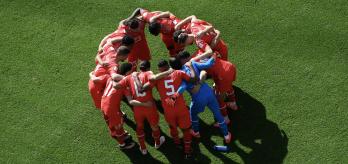After a lengthy career as a player, Ana Álvarez is now the Director of Women’s Football at the Spanish FA. In 2018, with the arrival of the president, Luis Rubiales, and his strategy of commitment and support to women’s football development, she was invited to take up a position in the marketing department of the newly formed women's FA. Since then, she has helped the profile of women’s football to increase dramatically. In a fascinating interview, Álvarez describes the successful restructuring that has taken place in the women’s game in recent times and how it continues to evolve.
Good practice
-
Establish a series of strategies, projects and measures, taking into account each territory.
-
Close work in the field with territorial federations to carry out the game’s development.
-
Use of feedback, analysis and reflection to tackle problems and grow.
Watch interview
Read summary
Part 1: Álvarez’s football journey
In the first part of the interview, Álvarez discusses her experience in football. After a successful playing career in the Spanish First Division, she became involved in sports management in the Spanish men’s futsal league. From 2018, she took up a restructuring position in the women’s Spanish Football Federation’s marketing department, and last year she became the director of women’s football.
Part 2: Coordinating strategies
In the second section, Álvarez describes how the women’s football department has evolved since its creation in 2018, going from only having a solitary employee to now having seven dedicated individuals working exclusively for women’s football, receiving support from other departments such as operations, events, legal, competition, marketing, RSC, and media services.
She explains how the department looks after all the women’s teams from the four categories and how, after restructuring, everybody is now in a position to think exclusively about women’s football, which is fundamental to the growth of the game. She goes on to talk about the Spanish ecosystem in more detail and how strategic approaches come about and how they are filtered down to the territorial federations.
Part 3: The evolution of the competitive structure in Spain
Álvarez describes a pyramid of competition in the women’s game that was unbalanced when President Luis Rubiales and his team took charge at the Spanish FA in May 2018. To plug the disparity at the highest levels, a new category was introduced, a second intermediate category, and this became the second tier below the First Division.
She believes that this has added stability to the competitive structure and further improvements to competition regulations and player conditions are being added every year as the game matures and evolves. She also explains the restructuring of the Spanish Cup, pointing out how it is now contested by 48 teams, in contrast to only 8 teams back in 2018.
Álvarez discusses how this restructuring has helped to generate competitive spaces that are more appropriate to the training and development of players who now have more minutes, more categories and more clubs to develop their game. Statistically, the number of registered players has increased by 30% and, from a strategic perspective, one of their great objectives is to increase this number by 10% every year. She also gives her positive views on mixed-gender football in Spain, believing it helps many girls develop their passion and continue playing football.
Part 4: The regional teams tournament
In the final part of the interview, Álvarez describes the regional teams tournament and its importance. Players from each region compete, defending the colours of their region, in a tournament that is very useful for player recruitment. It is an additional competition beyond the domestic leagues that is competed amongst young players at U12, U15 and U17 levels. Together with sporting performance, it is also important for the promotion of the values of commitment, education and child protection.















